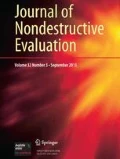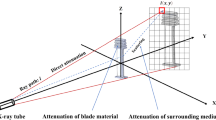Abstract
During the manufacturing and service process of turbine blades, various types of defects may be formed and bring huge threat to the safe operation of gas turbine. However, if qualifying the turbine blade only by the existence of defects, it will lead to the unavoidable large waste. Preferably, it should determine whether the turbine blades with defects could be in safe service for some period of time. Therefore, the residual strength and fatigue life should be analyzed and predicted based on the three-dimensional feature of defect, such as size, location. Considering the characteristics of shape (free-from surface) and material (high density superalloy), the radiographic imaging based techniques could be used in the non-destructive testing of turbine blades. For one thing, although the industrial computed tomography can obtain the three-dimensional feature of defects, the low efficiency and high cost may limit its practical application. For another, the projective nature of digital radiographic imaging technique results in the unavailability of geometric parameter in the transmitting direction and brings difficulty to the three-dimensional characterization of defect. Aiming at this critical issue, a new method based on the determination of mapping relationship between the thickness of material and the gray value of image is presented in this paper. By acquiring the thickness of two defects in a gas turbine blade, the three-dimensional geometric parameter (volume) can be calculated. Finally, the accuracy of the proposed method is verified using a test specimen. In comparison with the industrial CT, the proposed method could have relative high efficiency and low cost in the application of the three-dimensional quantitative characterization of defects for gas turbine blades.












Similar content being viewed by others
References
Liu, J.F., Liu, J., Wan, J., Wang, Z.Q., Yu, D.R.: Early fault detection of hot components in gas turbines. J. Eng. Gas Turbines Power (2017). https://doi.org/10.1115/1.4034153
Carter, T.J.: Common failures in gas turbine blades. Eng. Fail. Anal. 12(2), 237–247 (2005). https://doi.org/10.1016/j.engfailanal.2004.07.004
Gallardo, J.M., Rodriguez, J.A., Herrera, E.J.: Failure of gas turbine blades. Wear 252(3–4), 264–268 (2002). https://doi.org/10.1016/S0043-1648(01)00885-7
Zhou, D.J., Wei, T.T., Zhang, H.S., Ma, S.X., Weng, S.L.: A damage evaluation model of turbine blade for gas turbine. J. Eng. Gas Turbines Power (2017). https://doi.org/10.1115/1.4036060
Nowell, D., Duo, P., Stewart, I.F.: Prediction of fatigue performance in gas turbine blades after foreign object damage. Int. J. Fatigue 25(9–11), 963–969 (2003). https://doi.org/10.1016/s0142-1123(03)00160-9
Oakley, S.Y., Nowell, D.: Prediction of the combined high- and low-cycle fatigue performance of gas turbine blades after foreign object damage. Int. J. Fatigue 29(1), 69–80 (2007). https://doi.org/10.1016/j.ijfatigue.2006.02.042
Fleury, R.M.N., Nowell, D., Sui, T., Ying, S., Korsunsky, A.M., Tai, Y.H., Silva, F.: Characterisation of handling and service surface damage on Nickel alloys caused by low velocity impacts of blunt hard objects. Mech. Mater. 107, 45–55 (2017). https://doi.org/10.1016/j.mechmat.2017.02.003
Fleury, R.M.N., Nowell, D.: Evaluating the influence of residual stresses and surface damage on fatigue life of nickel superalloys. Int. J. Fatigue 105, 27–33 (2017). https://doi.org/10.1016/j.ijfatigue.2017.08.015
Fleury, R.M.N., Salvati, E., Nowell, D., Korsunsky, A.M., Silva, F., Tai, Y.H.: The effect of surface damage and residual stresses on the fatigue life of nickel superalloys at high temperature. Int. J. Fatigue 119, 34–42 (2019). https://doi.org/10.1016/j.ijfatigue.2018.09.024
Lindgren, E.: Detection, 3-D positioning, and sizing of small pore defects using digital radiography and tracking. EURASIP J. Adv. Signal Process. (2014). https://doi.org/10.1186/1687-6180-2014-9
Fuchs, T.O.J., Hanke, R.: 3D X-ray tomography—basics and latest developments. In: Ida, N., Meyendorf, N. (eds.) Handbook of Advanced Non-destructive Evaluation, pp. 1–14. Springer, Berlin (2018). https://doi.org/10.1007/978-3-319-30050-4_22-1
De Chiffre, L., Carmignato, S., Kruth, J.P., Schmitt, R., Weckenmann, A.: Industrial applications of computed tomography. CIRP Ann. 63(2), 655–677 (2014). https://doi.org/10.1016/j.cirp.2014.05.011
Haith, M.I., Huthwaite, P., Lowe, M.J.S.: Defect characterisation from limited view pipeline radiography. NDT E Int. 86, 186–198 (2017). https://doi.org/10.1016/j.ndteint.2016.12.007
Lindgren, E.: Detection and 3-D positioning of small defects using 3-D point reconstruction, tracking, and the radiographic magnification technique. NDT E Int. 76, 1–8 (2015). https://doi.org/10.1016/j.ndteint.2015.07.004
Li, B., Chen, L., Wang, Y.G., Gao, M.Q.: 3D detection of internal defects for gas turbine blades. Insight 59(7), 364–370 (2017). https://doi.org/10.1784/insi.2017.59.7.364
Acknowledgements
The authors are grateful for the financial support provided by the “Aero Engine & Gas Turbine” National Science and Technology Major Project (2017-VII-0008-0101), the Fundamental Research Funds for the Central Universities (xjj2017016) and the National Natural Science Foundation of China (51421004).
Author information
Authors and Affiliations
Corresponding author
Additional information
Publisher's Note
Springer Nature remains neutral with regard to jurisdictional claims in published maps and institutional affiliations.
Rights and permissions
About this article
Cite this article
Chen, L., Li, B., Zhou, H. et al. Detection of Three-Dimensional Parameter of Defects for Gas Turbine Blades Based on Two-Dimensional Digital Radiographic Projective Imaging. J Nondestruct Eval 38, 101 (2019). https://doi.org/10.1007/s10921-019-0640-3
Received:
Accepted:
Published:
DOI: https://doi.org/10.1007/s10921-019-0640-3




